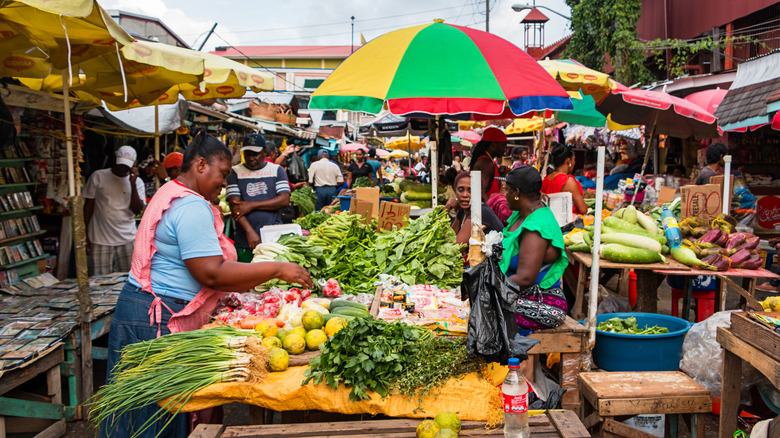South America's Only English-Speaking Country Is Also One Of Its Most Underrated
Guyana's highlights are hidden. Its colossal waterfalls thunder deep in the thick of the Amazon jungle. Its jaguars slink unseen between ceiba trees, subtly stalking unwitting prey. Six-foot caimans lurk just under the surface of the forest shrouded rivers. And its vibrant Caribbean culture is still unnoticed by the bulk of travelers in the outside world. The underrated country on South America's Caribbean coast is the only South American country with English as the official language. It attracts far fewer visitors than neighboring Brazil, but its wild interior deserves attention.
There are only two types of season in Guyana – the wet seasons, and the dry. Avoid traveling when rains are pelting the forests, the roads are washed to mud and many of the country's best attractions become inaccessible entirely. Travel between late August and early November to avoid the showers. Flights from the U.S. land at Cheddi Jagan International Airport, from which the capital of Georgetown is easily accessible although travelers should be cautious as Georgetown is considered one of the most dangerous Caribbean destinations.
Find hidden Amazon treasures in this rarely visited jungle region
Dubbed the "Land of Many Waters," a web of water weaves between the forests and the settlements of Guyana's wild interior. The most dramatic among them is the gargantuan Kaieteur Falls, located in Kaieteur National Park, the world's largest single-drop waterfall. Its occluded, so deep in the midst of untraversable jungle that the best way to catch a glimpse is to board a flight in Georgetown. Either opt for a scenic flight, catching the rainbows glimmering over the cascade edge from the comfort of a small plane, or embark on a multi-day rainforest expedition. Trek through the forest that covers 80% of Guyana — sleeping wrapped in mosquito net in hammocks strung from vast canopy boughs and listening to the cacophony of Amazonian animals that plays through the night — until you reach the waterfall edge.
Beyond the thrashing falls, there are many tour companies offering expeditions into the Amazon on the surface of its weaving rivers. Many of the jungle's rarest and most intriguing wildlife species live with the Guyanese depths, cooling at the water's edge. Spot calm capybara's mingling on the banks and listen out for the echoing screeches of red howler monkeys. Drift past the protruding snouts of skulking caimans and watch the Guianan cock-of-the-rock preform his elaborate mating dance. Extremely lucky visitors might even spot some of the Amazon's most dangerous animals – jaguars rule the jungle and intensely poisonous frogs glow neon green from the sides of the trees.
Enjoy Caribbean culture in Guyana's vibrant capital
As the South American outpost of the British Empire, Guyana received an influx of immigrants from all over the worldduring its colonial era. From the Caribbean, India, China, and Brazil, cultures and cuisines arrived and began to blend with the local Indigenous population. It's easy to see their influence in the eclectic and underrated cuisine in the capital. Sit down stall-side at a local market and pile Indian roti with west African style okra and Caribbean fried plantain, all topped with Brazilian farinha. Or tuck into a bowl of the country's national dish, pepperpot, a rich braised beef stew infused with the spice of the endemic wiri wiri peppers, cinnamon, clove, and thyme.
The cultural influence of the Caribbean is evident in day-to-day life, but its more obvious in its celebrations. Attend the Cricket Carnival to watch parades so flamboyant they could rival Trinidad's, and cricket matches cheered on by passionate Windies crowds. Or catch the Mashramani festivities that commemorate Guyana's independence from the British. It's marked by spinning parades of crystal-clad dancers twirling to the calypso and steel pan beats found pounding at every carnival across the Caribbean.


